Related Research Articles

The United States Postal Service (USPS), also known as the Post Office, U.S. Mail, or Postal Service, is an independent agency of the executive branch of the United States federal government responsible for providing postal service in the U.S., its insular areas, and its associated states. It is one of the few government agencies explicitly authorized by the Constitution of the United States. As of 2023, the USPS has 525,469 career employees and 114,623 non-career employees.
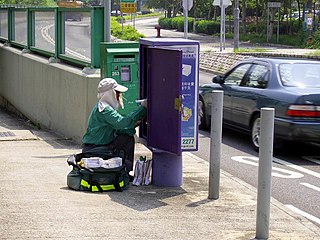
The mail or post is a system for physically transporting postcards, letters, and parcels. A postal service can be private or public, though many governments place restrictions on private systems. Since the mid-19th century, national postal systems have generally been established as a government monopoly, with a fee on the article prepaid. Proof of payment is usually in the form of an adhesive postage stamp, but a postage meter is also used for bulk mailing.

A ZIP Code is a system of postal codes used by the United States Postal Service (USPS). The term ZIP was chosen to suggest that the mail travels more efficiently and quickly when senders use the code in the postal address.
The Private Express Statutes (PES) are a group of United States federal civil and criminal laws placing various restrictions on the carriage and delivery of letters by all organizations other than the United States Postal Service.
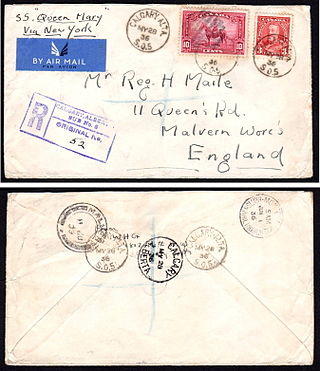
Registered mail is a postal service in many countries which allows the sender proof of mailing via a receipt and, upon request, electronic verification that an article was delivered or that a delivery attempt was made. Depending on the country, additional services may also be available, such as:
Franking comprises all devices, markings, or combinations thereof ("franks") applied to mails of any class which qualifies them to be postally serviced. Types of franks include uncanceled and precanceled postage stamps, impressions applied via postage meter, official use "Penalty" franks, Business Reply Mail (BRM), and other permit Imprints (Indicia), manuscript and facsimile "franking privilege" signatures, "soldier's mail" markings, and any other forms authorized by the 192 postal administrations that are members of the Universal Postal Union.
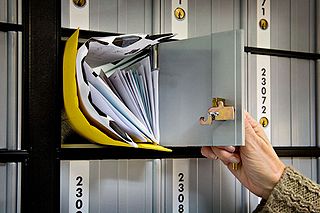
A post office box is a uniquely addressable lockable box located on the premises of a post office.
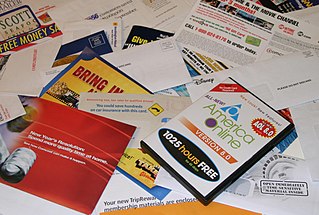
Advertising mail, also known as direct mail, junk mail, mailshot or admail, letterbox drop or letterboxing (Australia), is the delivery of advertising material to recipients of postal mail. The delivery of advertising mail forms a large and growing service for many postal services, and direct-mail marketing forms a significant portion of the direct marketing industry. Some organizations attempt to help people opt out of receiving advertising mail, in many cases motivated by a concern over its negative environmental impact.

Freepost is a postal service provided by various postal administrations, whereby a person sends mail without affixing postage, and the recipient pays the postage when collecting the mail. Freepost differs from self-addressed stamped envelopes, courtesy reply mail, and metered reply mail in that the recipient of the freepost pays only for those items that are actually received, rather than for all that are distributed. Freepost of preprinted cards issued by businesses is also different from postal stationery sold by postal administrations.

The Facing Identification Mark, or FIM, is a bar code designed by the United States Postal Service to assist in the automated processing of mail. The FIM is a set of vertical bars printed on the envelope or postcard near the upper edge, just to the left of the postage area. The FIM is intended for use primarily on preprinted envelopes and postcards and is applied by the company printing the envelopes or postcards, not by the USPS.
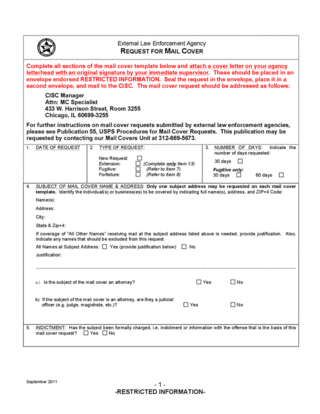
Mail cover is a law enforcement investigative technique in which the United States Postal Service, acting at the request of a law enforcement agency, records information from the outside of letters and parcels before they are delivered and then sends the information to the agency that requested it. The Postal Service grants mail cover surveillance requests for about 30 days and may extend them for up to 120 days.
Remote Bar Coding System (RBCS), also called Remote Video Encoding (RVE) is a method used by the United States Postal Service to encode the address of letter-sized mailpieces that are not decipherable by a Multiline Optical Character Reader (MLOCR). When an MLOCR does not recognize a valid address on a letter, it sends an image of the mailpiece to a central RBCS (RVE) site where more sophisticated optical character recognition software is able to interpret many hand-written addresses using neural net and fuzzy logic algorithms. If this does not succeed, human operators visually examine the image and enter the address. In both cases, the data is sent back to the originating mail facility where mailpieces are then automatically matched back up with data through the use of a unique fluorescent barcode printed on the back during initial MLOCR attempt, and receive a POSTNET barcode representing the full address.
Click-N-Ship is a service offered by the United States Postal Service that allows customers to create pre-paid Priority Mail shipping labels on ordinary printer paper. The labels include delivery confirmation numbers to track date and time of delivery or attempted delivery. Other than the cost of postage, there is no fee to create labels for Priority Mail, Priority Mail Express, Global Priority Mail, or Global Express Mail if the sender uses USPS Flat Rate envelopes or boxes.
A Digital Postmark (DPM) is a technology that applies a trusted time stamp issued by a postal operator to an electronic document, validates electronic signatures, and stores and archives all non-repudiation data needed to support a potential court challenge. It guarantees the certainty of date and time of the postmarking. This global standard was renamed the Electronic Postal Certification Mark (EPCM) in 2007 shortly after a new iteration of the technology was developed by Microsoft and Poste Italiane. The key addition to the traditional postmarking technology was integrity of the electronically postmarked item, meaning any kind of falsification and tampering will be easily and definitely detected.

The Intelligent Mail Barcode (IMb) is a 65-bar barcode for use on mail in the United States. The term "Intelligent Mail" refers to services offered by the United States Postal Service for domestic mail delivery. The IM barcode is intended to provide greater information and functionality than its predecessors POSTNET and PLANET. An Intelligent Mail barcode has also been referred to as a One Code Solution and a 4-State Customer Barcode, abbreviated 4CB, 4-CB or USPS4CB. The complete specification can be found in USPS Document USPS-B-3200. It effectively incorporates the routing ZIP Code and tracking information included in previously used postal barcode standards.
Rowan v. Post Office Dept., 397 U.S. 728 (1970), is a case in which the United States Supreme Court ruled that an addressee of postal mail has sole, complete, unfettered and unreviewable discretion to decide whether he or she wishes to receive further material from a particular sender, and that the sender does not have a constitutional right to send unwanted material into someone's home. It thus created a quasi-exception to free speech in cases in which a person is held as a "captive audience".
National Change of Address (NCOALink) "is a secure dataset of approximately 160 million permanent change-of-address (COA) records consisting of the names and addresses of individuals, families and businesses who have filed a change-of-address with the USPS". It is maintained by the United States Postal Service and access to it is licensed to service providers and made available to mailers. There are six licenses available including Full Service Providers and Limited Service Providers. The use of NCOALink is required in order to obtain bulk mail rates, as it minimizes the number of UAA mailpieces saving the mailer money and reducing the USPS's processing of this type of mail.

Mail sorting refers to the methods by which postal systems determine how and where to route mail for delivery. Once accomplished by hand, mail sorting is now largely automated through the aid of specialized machines. The first widely adopted mail sorting machine was the Transorma, first made operational in Rotterdam in 1930.
Informed Delivery is a feature offered by the United States Postal Service (USPS) whereby consumers can digitally preview incoming mail and manage packages scheduled to arrive soon.
Unsolicited advertisement comprise all of, but are not limited to:
References
- 1 2 3 "Publication 307 - Stop Unsolicited Sexually Oriented Advertisements in Your Mail" (PDF). United States Postal Service. March 2008. Retrieved 2008-06-05.
- ↑ "Domestic Mail Manual 508 Recipient Services, §8.1.7". United States Postal Service. Retrieved 2008-06-05.
- 1 2 Rowan v. U.S. Post Office Dept. , 397U.S.728 (1970).
- ↑ Ritchie Hallanan Real Estate, Ltd., No. P 03-393 (Postal Service Admin. DecisionMay 18, 2004).
- 1 2 3 4 5 39 U.S.C. § 3008
- ↑ 39 CFR 963